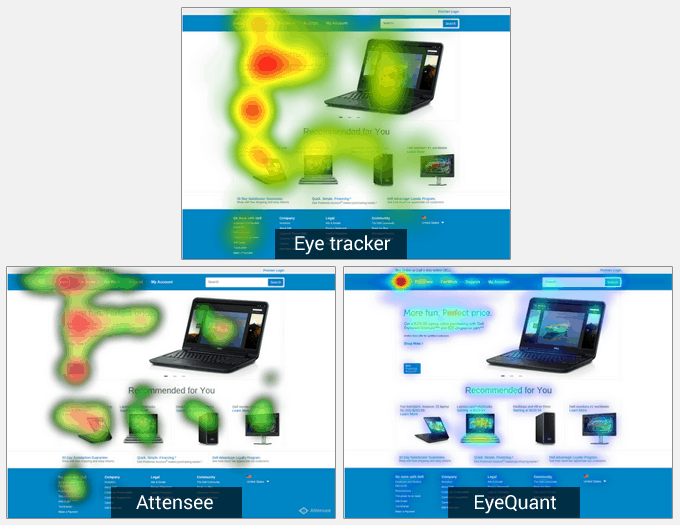
The ability to see what the user is seeing can bring another perspective to understanding how a website design is performing. Once a user visits your site, you don’t have much time to act. The way you use the little amount of his/her attention results in the ROI rate of your traffic spends. Is the CTA button you’ve put so much hope in seen at all? No? Maybe the stock picture is grabbing too much users’ attention without leading to any particular action? Knowing these things is essential when designing layouts with business goals in mind.
While being very insightful, eye tracking is still unheard of to be broadly used in conversion rate optimization or user experience studies. A proper eye tracking study is still quite unreachable due to its complexity and the fact that it takes a lot of time to conduct. The Internet likes things which are fast and give instant results. Attensee is one of these things. It connects the practical easiness & speed of conducting survey research with eye tracking’s power to deliver actionable behavioral data.
How does it work?
The research is conducted in a classic, survey-like way. You generate a page with tasks & questions and then send it out to the respondents. Attensee has been integrated with a research panel enabling to pick from over 10 million qualified participants from all over the world.
The task for the respondent is to explore the given image (website screenshot) in a blurred state with his/her mouse pointer. It’s been scientifically proven that facing a situation of distorted perception (blurred images) activates the human attention processing. The decisions on where to look are being made based on a limited information about the colors and shapes of particular objects. Attensee lets you capture and analyze these processes providing gaze paths visualizations and eye fixation heat maps.
The closest you can get to eye tracking
There are a few companies in the market that offer a so-called predictive eye tracking method. Most of them claim a 75-90% correlation with real eye tracking data. This data seems quite promising, but we weren’t able to find any convincing studies that would support this claim. We have decided to try EyeQuant (predictive eyetracking method) and compare the results with a real eye tracker Tobii T60, tested on 15 participants in 2 days time. Attensee study was conducted on 60 participants and took about an hour.

These heat maps can pretty much speak for themselves. We can clearly see a high correlation of fixation points placement when it comes to Attensee and Tobii eye tracker, while EyeQuant’s prediction seems to be far from reality. The main reason for that is the fact that both Attensee and Tobii output the research made on real people, in realtime. Why to predict when you can see the real thing? Attensee will never replace a lab-based eye tracking research. However, it can be successfully used when you need fast results, which are credible enough to make the same design decisions as you would based on eye tracking data.
Only this month, Attensee offers full access to all its features for 90 days for only $19. Just try it and see for yourself. It gives perfect results. If for some reason you’re not satisfied – 100% money-back guaranteed.
Disclaimer: The opinions expressed in this article are as provided by the company’s PR agency. Regardless, I only publish reviews of products or services that I believe will be good for my readers. I am disclosing this in accordance with the Federal Trade Commission’s 16 CFR, Part 255: “Guides Concerning the Use of Endorsements and Testimonials in Advertising.
Want to learn more?
If you’d like to…
- get an industry-recognized Course Certificate in Usability Testing
- advance your career
- learn all the details of Usability Testing
- get easy-to-use templates
- learn how to properly quantify the usability of a system/service/product/app/etc
- learn how to communicate the result to your management
… then consider taking the online course Conducting Usability Testing.
If, on the other hand, you want to brush up on the basics of UX and Usability, then consider to take the online course on User Experience. Good luck on your learning journey!
